#rain world worldbuilding
Explore tagged Tumblr posts
Text
What is the Rot? Why is the Rot?
Spoiler Warning and Holy Wall of Text Batman Warning. I got WAY too into questioning the turbo-cancer here, hopefully my rambling makes sense.
So, the Rot is… weird, from a biological standpoint. Really weird, if you stop to think about it. It’s most frequently described as some variation of cancer, and it certainly fits the criteria for it. Caused by damage to DNA? Check. Multiplies uncontrollably? Check. Comes in both benign and malignant forms, one stationary and the other mobile? Big fat check. Heck, even the Rot cysts eating other creatures kind of fits, according to some research I’ve done – there are apparently cancer cells that will eat other cells, which makes sense in hindsight since cancer cells are cells that have lost important genetic restrictions, which may include whatever lets cells identify other cells as “do not eat.”
(I ain’t a biology whiz and I’m doing research on the fly while getting my thoughts out here, so take whatever I say about biology with a grain of salt)
So, Rot is clearly cancer of some kind, right? Case closed. Except when me and a friend of mine were talking Rain World theories on Discord, she brought up some interesting points that got me thinking.
First point: Rot cells obviously mutate in a way that affects FAR more than just cell replication and termination. Some of the cysts can HEAR. As far as I know, cells in the body do not hear sounds. They communicate via chemical signals and maybe, MAYBE react to temperature. Hearing involves complicated, specialized sensory apparatus to pick up on vibrations in the air. Even if you simplify it and say that it’s only vibrations, that’s STILL a multicellular thing, not a single-cell thing. It’s something that took millions of years to evolve on Earth, if not billions.
And while Rain World’s timeline goes on for long enough that it those kinds of mutations might happen eventually, Rot cysts have the ability to hear pretty much right from the start – because even the Proto-Long-Legs react to your presence like the Daddy Long Legs do, and the Rot in Spearmaster’s campaign, where Pebbles has recently contracted it, reacts the same way as it does in later campaigns. It’s already able to hear.
As far as I know, cancer just means the same cell duplicating over and over again. Are more mutations possible with each division, as errors are made in the DNA during splitting? Probably. But not to THAT extent. There’s no way a lump of cancer somehow mutated the exact complicated genetic blueprint needed to grow organs, at least not without outside interference.
Second point: Cases of Rot are way too consistent across the board. Now, we don’t have a huge sample size to work from, but from what we see from both Pebbles’ Rot, and Hunter Long Legs, they’re… pretty similar. Hunter Long Legs is basically a mobile Rot cyst. They move the same way, seem to grow the same way (starts as a growth inside/on the body before eventually freeing itself from whatever wall/flesh it grew from in some capacity and moving elsewhere), they have the same senses, and they even eat the same way, via something like phagocytosis (how white blood cells “eat” invading organisms via engulfing them and breaking them down in a sac in their main “body.”)
Now, this doesn’t tell us much, because cancer, when it does emerge, is pretty consistent in symptoms/what the mutated cells do once they start replicating. It’s pretty much the same regardless of whatever organism the cancer is happening in. But what ISN’T consistent is what causes the DNA error in the cancer cell in the first place. IRL, cancer can be caused by all kinds of things – smoking, radiation poisoning, being out in the sun too long, drinking deadly chemicals and whatnot, anything that damages DNA. But in RW, the only time we ever hear Rot talked about, or see it present, is in the context of an iterator having f*cked up while mucking around with DNA. Pebbles was trying to create an organism that could change his own genome, and No Significant Harassment created Hunter as a messenger and probably mucked something up in the process in his haste to get them to Moon.
This doesn’t mean that there aren’t other causes of it, of course, we’re working with a sample size of two in an apocalyptic world with who knows how much potentially DNA-damaging stuff around, but… that’s still awfully consistent.
So, combining these points and everything we know to be canon, Rot is:
an organism that lives inside another organism
Until a certain condition is met, it cannot harm said host organism.
Once said condition is met, it goes out of control, wreaking havoc on the organism’s systems and mutating, giving it sensory capabilities and an appetite
Said condition is apparently someone messing up when re-arranging genomes, in yourself or others
It is widespread across multiple different species, at least iterators and slugcats but potentially other species as well.
Once you have a bad case of it, it is apparently NOT CURABLE. Pebbles tried everything he could think of but apparently exhausted all of his options by the time of the Survivor/Monk campaigns.
So, with all the context FINALLY laid out, here’s my wild theory: Rot isn’t a cancer. It’s a symbiote turned parasite. Specifically, I believe it’s a symbiotic microbe that lives inside the cells that make up every other creature in Rain World, and is held in check by a specific gene that all species share, and altering or getting rid of that gene causes it to go berserk, taking over and eventually mutating the host cells.
Yeah, I did watch Parasite Eve let’s plays as a kid, why do you ask? Anyway, hear me out here.
There is precedence for single-celled organisms living inside of other single-celled organisms. They’re referred to as intracellular endosymbiots (hopefully I got the spelling right there), and the most well-known one is probably the mitochondria. The powerhouse of the cell is thought to be descended from some bacteria way, WAY back that was engulfed by a larger cell and not only survived it, but BENEFITED from it. Since then those ancient proto-mitochondria and eukaryotic cells have mutually evolved to be dependent on each other. So it’s entirely possible for something similar to have happened in Rain World.
However, I don’t think it happened NATURALLY, here. Because something that’s able to take over a cell entirely and begin wildly mutating it is NOT something your average cell wants inside of it. There’s a VERY high chance of extinction if you do that. Which means that of course those funky bio-tech loving Ancients either took a look at a wildly dangerous cellular parasite and went “hmmm we can use this” or made one themselves.
Why did they do this? Who knows! Currently, I’m tied between “they needed a better powerhouse for the cell to power the various weird adaptations they’re building into various creatures,” “there was some sort of disease that this parasite gave immunity against and they wanted to make use of it,” and “it gave their creations massively powerful regeneration factors that made them much easier to maintain.” Possibly it was all three. Whatever the reason, the Ancients either found or created this parasite, and put it into their creations’ cells, hoping to reap the benefits.
Well, they got the benefits, but they also got a microbe that hijacked the cells and harnessed their pre-existing DNA blueprints to build organisms disguised as great big blobs of cancer. Which is not exactly ideal, but hey, they just had to figure out a way of keeping the cell hijacking from happening! And the way they ended up going about it was to alter the thing so that so long as there was a specific DNA sequence in the cell, it laid mostly dormant. All the benefits, none of the risks – so long as that specific string of genes remained intact.
And then BECAUSE it was so beneficial, they spread their artificial symbiote and it’s genetic reins throughout ALL of their creations, from the smallest pipe-cleaning slugs to the iterators. Which meant that as their purposed organisms replaced most of the original ecosystem, they spread the symbiote as well. Thus making it possible for pretty much ANY creature on the planet to come down with a bad case of the Rot. And with the iterators, I wouldn’t be surprised if this symbiote is tied to their self-destruction taboos. Try to cross yourself out? Well, it’s gonna maybe happen now, but it’ll be a slow painful death as you’re eaten alive from the inside and all your own parts turn against you, so was it really worth it?
And they never told their creations this perhaps even actively hid it, because why tell them the cause of the main deterrent to them mucking with their taboos? They might find a way around it. The iterators were left ignorant of how Rot works, and because of this they never figured out that Rot HAD a cure after all: rebuilding that genome that reins in the symbiote. Because why in the name of the Void would they repeat the same mistakes that gave them Rot in the first place, and potentially make it worse?
#rain world#rain world worldbuilding#serious musings#rain world headcanons#rw rot#the rot#rain world rot#rain world turbo cancer#which is not actually cancer#yes i Parasite Eved the shit out of the Rot#yes that is a verb now I take no criticisms#anywho the Rot is a byproduct of the ancients Fucking Shit Up on Purpose#and it DOES have a cure damn it#I'm not giving the robots not-actually-cancer and NOT giving them at least a chance to cure it#not mentioned above is the fact that depending on the genes altered along with the restraining gene#you might get rot with fun mutations like being able to jump from organism to organism#or Rot that outright assimilates cells from other organisms#amongst other things#plenty of FUN stories to play with there >:D
306 notes
·
View notes
Text


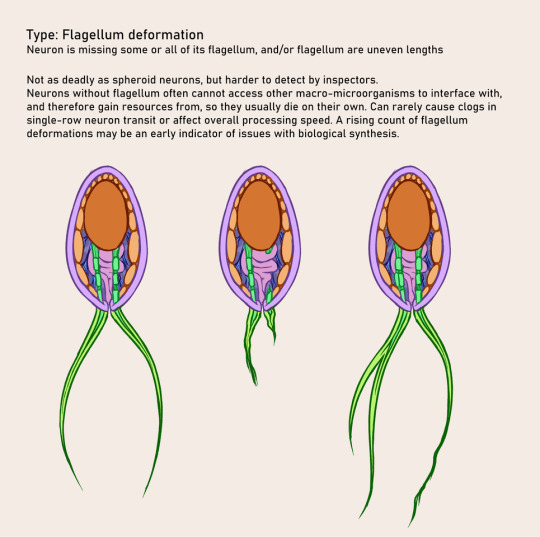


Neuron misproduction ideas that spawned from this ask about iterators getting sick - maybe more along that line in the future?
Full transcript under the cut.
Neuron Misproduction
--
Neuron flies are comparable to living RAM for iterators. Their purpose is to process short-term information.
They are mostly made out of fat. A high-calorie snack for a slugcat.
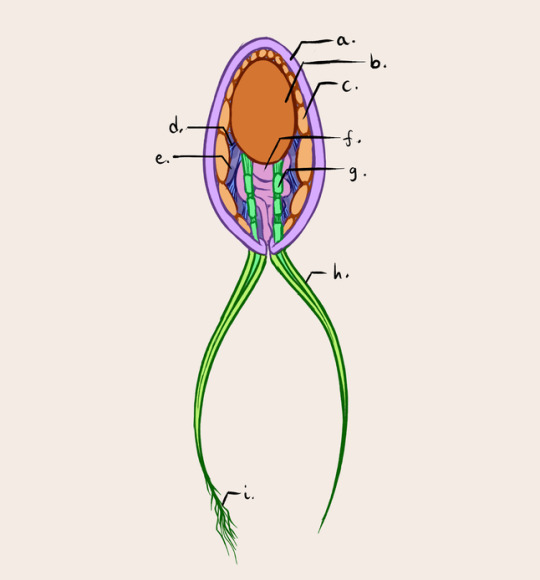
Simplified anatomy chart labels each part of the body:
a. Protective membrane (Encapsulates the neuron)
b. Nucleus. (Large ellipsoid at the top-center of the neuron.) Longer-term data caching; oldest data is lost when it is overwritten by new data or when the cache is flushed.
c. Processing organelles. (Several smaller ellipsoids that line the inside of the neuron's membrane.) Data is constantly and cyclically refreshed.
d. Anchoring/connective tissue between the nucleus and processing organelles.
e. Cytosol that provides structural integrity to the neuron fly, and facilitates storage and transport of various resources. (Fills all the extra space of the neuron)
f. Nutrient processing system. Neuron flies mostly function off direct energy transferral, but organic components are still necessary. Both are absorbed directly through other iterator macro-microorganisms. (Resembles a simplified digestive system)
g. Connective tissue between the nucleus and flagellum, used when directly interfacing with other iterator components. (Fibrous tissue surrounded by myelin sheaths, like an axon or the umbilical cord of an iterator)
h. Flagellum, primarily used for locomotion (Long whiplike protrusions on the bottom of the neuron fly)
i. Dendrites that unsheath when interfacing (Many tiny split ends at the end of the flagellum)
--
Type: Flagellum deformation Neuron is missing some or all of its flagellum, and/or flagellum are uneven lengths
Not as deadly as spheroid neurons, but harder to detect by inspectors. Neurons without flagellum often cannot access other macro-microorganisms to interface with, and therefore gain resources from, so they usually die on their own. Can rarely cause clogs in single-row neuron transit or affect overall processing speed. A rising count of flagellum deformations may be an early indicator of issues with biological synthesis.

Neuron 1: Typical
Neuron 2: Very reduced flagellum with some shriveling
Neuron 3: Left flagellum forks into a second partially-formed flagellum. Right flagellum exhibits slight shriveling and fraying at the end.
--
Type: Gutless body Neurons that often appear normal from the outside, but are missing essential internal components.
This neuron type can often be detected early through careful inspections. Often presents as a virtual husk, only capable of consuming energy and moving about.
Ironically, the nutrient processing system is sometimes enlarged, taking up more space where the other organelles are smaller or missing. This neuron type is relatively easy to remove when detected, and doesn't cause major issues other than resource consumption.

Neuron 1: Typical
Neuron 2: Enlarged nutrient processing system, no processing organelles, severely reduced nucleus
Neuron 3: All organelles are severely reduced, neuron is slimmer and mostly composed of cytosol
--
Type: Spheroid Neuron's body length is significantly reduced, often resulting in a spheroid shape.
A spheroid neuron has warped or missing crucial internal structures. It is more dangerous than a gutless neuron due to still being able to process, and therefore corrupt, or result in the loss of information.
Not all neurons of this type are spheroid; it's just named after the common distinct shape. Many neurons of this type lack structural integrity, and do not make it past the production phase.
In a healthy iterator, faulty neurons are rare, and are usually recycled before they can even leave the production phase, or are otherwise destroyed by inspectors.
Mass production of spheroid neurons indicate severe internal issues. At that point, equipment and inspectors likely are failing to recognize faulty neurons or, worse, are indiscriminately destroying all of them. This encourages a stressful rapid production of neurons, which may lead to further equipment failure.
Due to neuron flies' major role in memory encoding and retrieval, neuron corruption can disrupt active processes and cause errors in data storage. In severe cases, affected neurons can corrupt the macro-microorganisms they interface with, and vice versa in a cascade effect, possibly leading to seizures and dementia.

Neuron 1: Typical
Neuron 2: Very round and flattened neuron. Nucleus is partially split and merged with a processing organelle. The rest of the cytoplasm is squished.
Neuron 3: Membrane is pinched into the neuron. Lacks a clear nucleus. Flagella connection is fused at one segment, forming an X-shape.
Neuron 4: Membrane is pinched and folded in several areas, resulting in an unusual asymmetric shape. Organelles are reduced and shoved into whatever space is available. Only one flagellum is connected.
Neuron 5: Membrane is overgrown on one side, leaving little space for the cytoplasm. The nutrient processing system is partially ingrown within the membrane.
764 notes
·
View notes
Text

i rarely ever do worldbuilding for anything but here. have some scug worldbuilding .. if you even care
#rain world#rw slugcat#rw snail#i'm surprised the rw snail tag even exists#fanart#digital art#concept art#worldbuilding#doodles#joowee's art galore
4K notes
·
View notes
Text
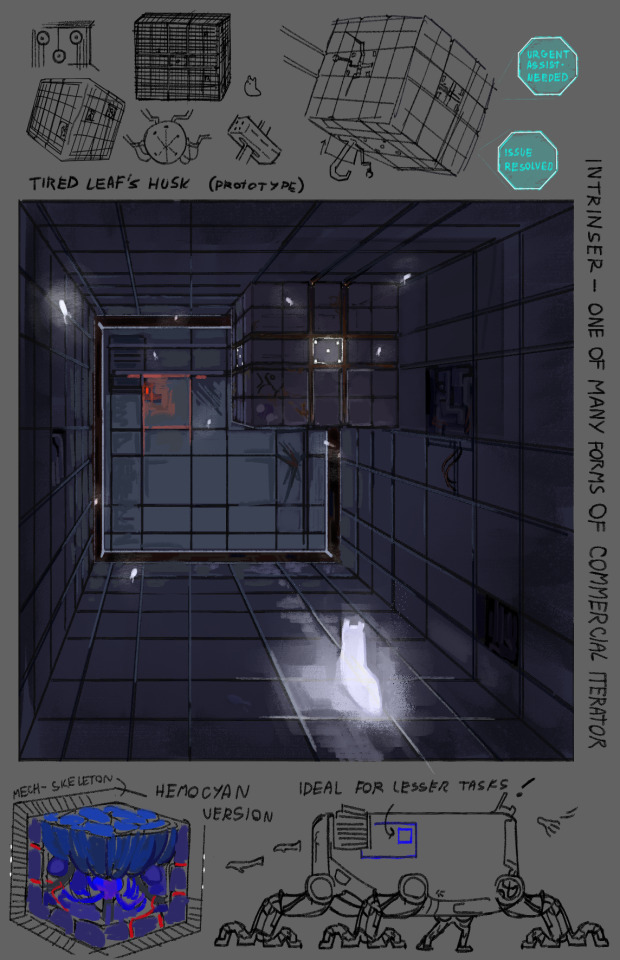
I wanted to finally design my iterator oc who's been in concept hells but I wasn't satisfied.
So here's just what sorta technology he is
Intrinsers were not as popular where Moon or Pebbles stand. There, energy was pushed more to get the final answer, and repair microbes seemed good enough to keep other machines long-lasting.
While the iterators most ancients grew up with had friendly faces, other living structures that were given sapience (or close to it) didn't need to become as presentable, resulting in a large variety of shapes.
Intrinsers have many of the same functions an abomination iterator has as they were being invented at the same time with more already being built before the first puppeted iterators emerged. They are much more often lower-function than their younger siblings with some barely qualifying for sapience.
Their main roles were more complicated and mobile mining and manufacturing tasks with some being the only source of a popular product in an ancient city. Someone has to make that pebbsi. Very few got to ever see an acient city tho.
#art#digital art#artwork#worldbuilding#fanart#rainworld art#rain world downpour#rain world#rw iterator#rain world iterator#rain moment....#rw art#speculative fiction
656 notes
·
View notes
Text
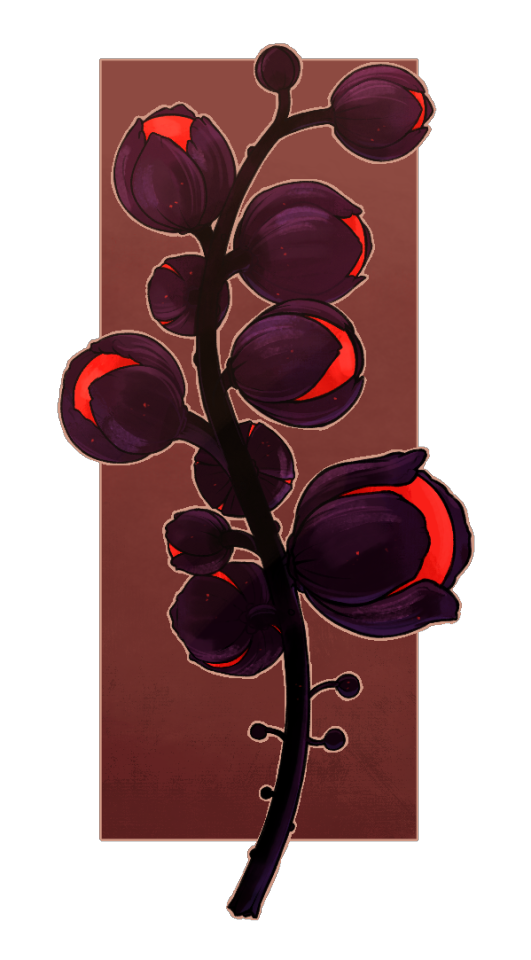
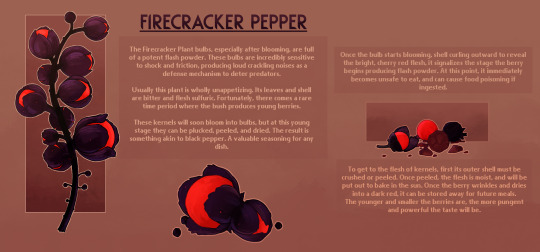
A small series I hope continue? Basically creating dishes out of Rain World fauna. But first I need to establish their flavors and uses.
#rain world#rain world fanart#rain world downpour#fanart#worldbuilding#speculative biology#spec bio#rw worldbuilding#delicious in rain world
1K notes
·
View notes
Text
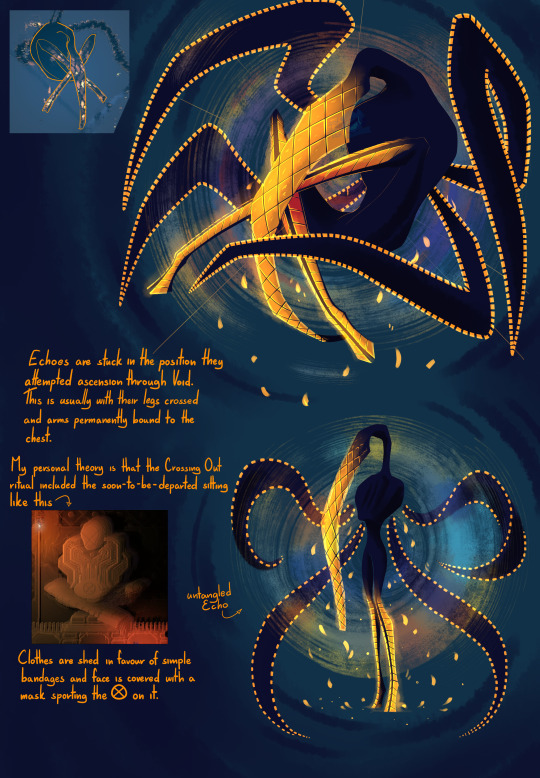
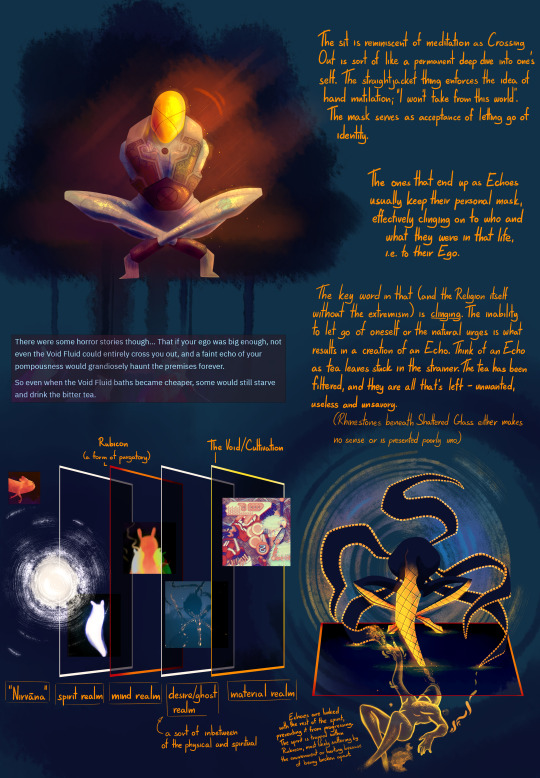
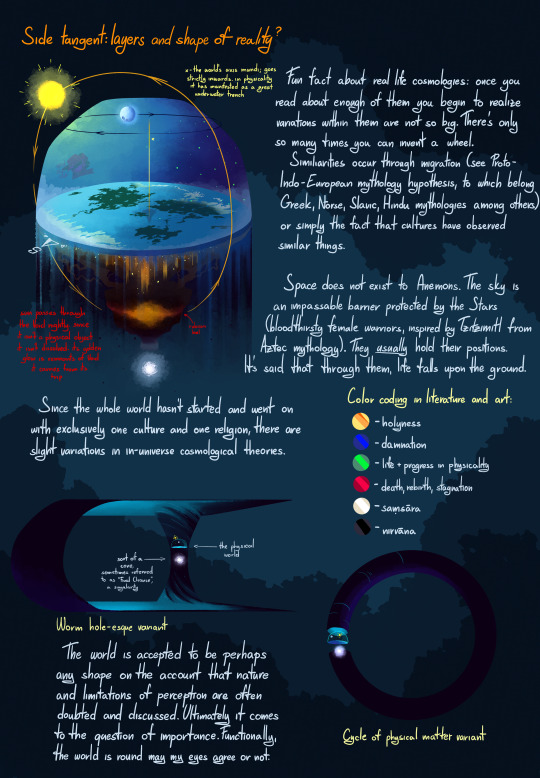
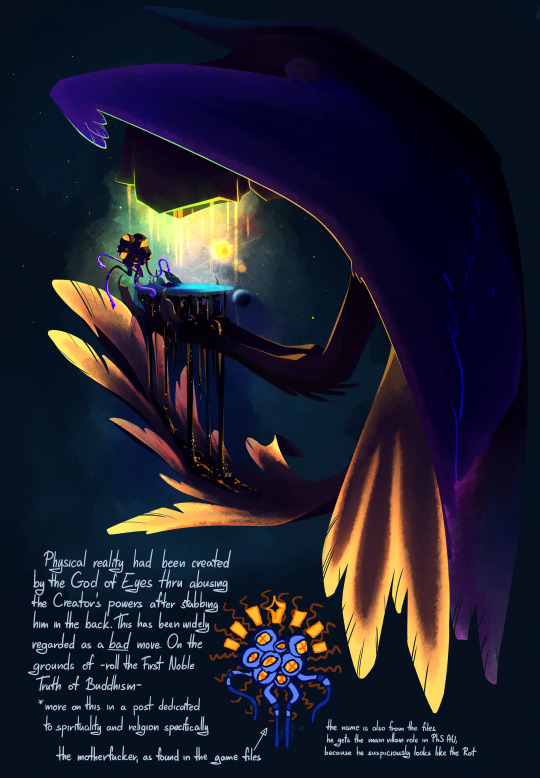

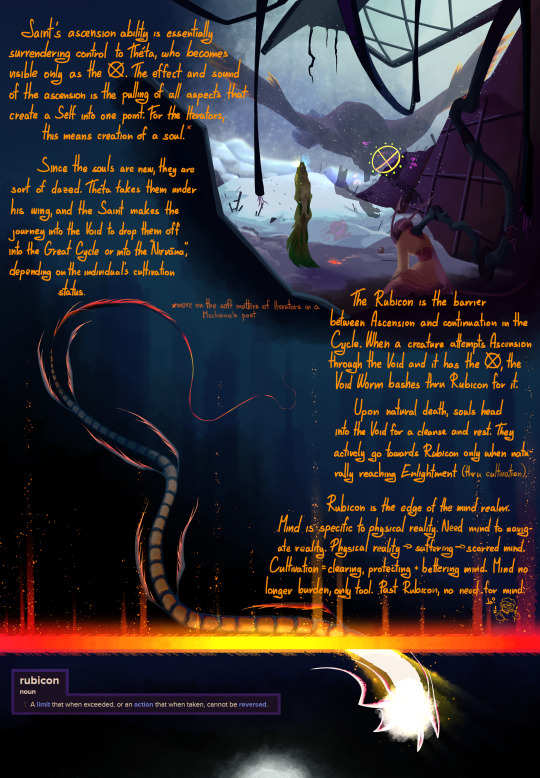
On the Echoes, cosmology, Saint's quest(/inner identity) and the Rubicon. Half of these are from February...
bonus Théta doodles:
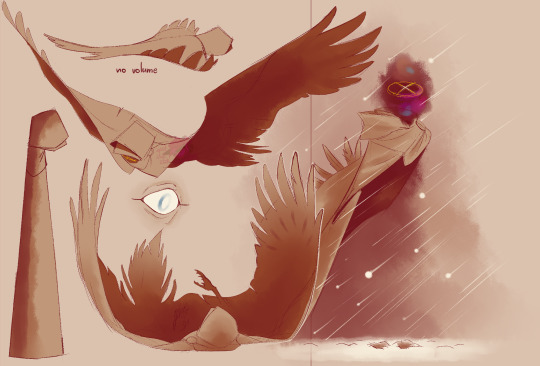
#rw#rain world#rw echo#rw ancients#rw saint#sliver of straw#five pebbles#oc: théta#philosophy sessions au#my art#the void reminds me of the myth of ahura mazda creating a filtration system within the earth to clean water of salt and sicknesses-#-inflicted by ahriman so the humans could have something to drink. and he clad it in gold to protect it from evil too#Best of Spotty Art#worldbuilding subject to changes
647 notes
·
View notes
Text
gotta say one of the more horrifying and gross implications of the benefactors' heavy use of purposed organisms has to be the fact that the walls of everything in metropolis (and other cities too) are probably filled with sedentary meat animals that have been there for centuries, possibly millenia, some of which almost certainly could not survive without regular input from their creators. i think maybe some of them could survive without whatevever food source they used (probably shit and garbage for the waste disposal ones and nutrient fluids or something for others) and and evolve into other things but i imagine a lot of them didnt and they just. decomposed in the walls. like can you imagine how bad the cities must've reeked within the first several months/years after public ascension as all the ones dependent on waste from living blocks just died of starvation and decomposed. i feel so bad for the iterators man
#on the bright side at least the meat wouldve fed the feral autonomous creatures like lizards and whatever else was around at the time#like a giant nyc-sized whale fall#sage screams incoherently#rain world#rain worldbuilding#rain world lore#rw lore
216 notes
·
View notes
Note
I'm curious,
If an Fairy changes court, like Upper(Fairy) to Circuit(Pixie), what happens to the Lower court(Anti-fairy) counterpart?
Do they just cease to exist? Will they come back if the change is reversed? Will they have any idea of what happened?
In addition to that, does the Leisure court(specialty fairies) have a Lower court counterpart, or is it just the Upper court that has that?
And if it's only the upper court that has that, why only them?

Besides Timmy, Pixies and Leisure fairies actually can't change courts! They're stuck the way they're born because they technically lack a living counterpart!
Leisure Fairies are bound to their specialty, while Pixies are bound to their work. But Uppers and Lowers are bound to each other, which is why they can swap places. If a fairy's counterpart dies or disappears, so does the original and vis-versa.
The only exception to this rule is if the "Binding" of the fairies are changed before the counterpart dies.
Additional fun fact! There's technically 4 Fairy "realms". They're stacked on top of each other, and it's progressively harder to get to each one the higher they are (Only Leisure Fairies can access ""Olympus"", for example). They have official names but nobody bothers to use them.
Bitties Series: [Start] > [Previous] > [Next]
#fairly oddparents#fop#fop a new wish#asks#valleymyristica#itty bitties fop au#yiipieeee worldbuilding!!!!#its hard for fairies to reach the Pixies' land because they. dont really have much foundational clouds for you to float on.#pixies are flighty creatures who spur up clouds where ever they go! so if you're not good at flying or constant movement you'll fall down#its nearly almost always raining in anti-fairy world. very gloomy. full of thunder and storms and the likes.#you could easily slip from fairy world INTO anti fairy world and then face the annoying hassles of trying to get back out#nobody's quite sure how to get to the supposed olympus#it takes a lot of strength and power to fly up that high that only leisure fairies have#jorgen used to be able to go up there but since he lost his wings hes been bound to fairy world unless he teleports#also also bindings!!!!#fairies all have a binding to something its just that they take different forms!#fairies and anti fairies are the weirdest ones because they're like. bound together.#which gives a misconception that for every fairy there's an equal and opposite fairy#absolutely none of this information is relevant to the storyline for itty bitties#i just think its neat :D
352 notes
·
View notes
Text
RW Headcanon: Know the Difference! | An Overview of Quetzalli's Slugcats
Here’s a headcanon I’ve wanted to elaborate on for a while, and today I finally felt compelled to make it real! Also, just a disclaimer I am not a huge biology nerd nor have I studied it that heavily, so I apologize if something here doesn’t make sense or if I get something wrong. I just like fantasy worldbuilding from time to time, and I always like trying to make sense of things I’m interested in!

-.-.-.-.-.-.-.-.-
Basically, I’m in the crowd that interprets slugcats as mustelids rather than literal slugs. When I say this, however I don’t mean that slugcats would necessarily be classified in the actual mustelidae family, seeing as Rain World’s world is most-likely not Earth and therefore our taxonomic classifications and phylogenetic relations can’t necessarily apply. Thus, when I call them “mustelids”, I really just mean that I imagine them as some kind of weasel with all the necessary physical traits to earn that general label.

The first half of the name “slugcat”, in my headcanon, is thus not referring to any literal connection to slugs or other mollusks, but is instead derived simply from their appearance. Due to their long ears and thick tail, and because their fur and fat often squishes together in such a way that it makes their features blend together and their bodies appear more smooth (it’s the same physics as that whole “cats are liquid” idea), the general silhouette of a slugcat can easily be likened to that of a literal slug. The second half of their name is also not literal, and instead refers to their jumping and acrobatic abilities and their skill in hunting and pouncing on small prey, which is very similar to that of small cats.
Species Overview
Now to give a little more detail on slugcats themselves as a species! I headcanon them as small to medium-sized mammals most similar to Earth weasels in both their biology and their ecological niche, who originally served as cute low-maintenance pets for the Ancients and as hunters of small pests in facilities on the ground. They’re clever by nature and good at fitting through tight spaces, and later on they evolved greater jumping abilities to pounce on prey. They’re also very social creatures, who’ve taken to forming medium to large colonies primarily in and around the massive trees that thrive between the cracks in iterators’ rainstorm areas (like the one Gourmand, Survivor, and Monk’s colony lives in). Due to this social nature they also generally travel in groups of at least two, both for company and protection against tougher animals. Travel partners are usually siblings or good friends, and sometimes even whole families will journey out together to find food and other resources for the rest of the colony.
Despite being a small prey animal, slugcats have managed to get by not only due to their intelligence — the evolution of which would be seen as a rather unexpected twist of events if you asked their creators, for the Ancients found them cute but rather simple — but because of their impressive adaptability. It’s similar to that of real life red foxes and pigeons, and it allows them to survive decently well even in less ideal environments; a trait especially necessary for a world as industrialized as this one, even if its people are gone and most of the machinery is inactive. As such not all colonies live in trees; some find homes in the abandoned facilities, large underground hollows, and a few bold colonies have even claimed territories high up in iterator cities alongside scavengers. Slugcats are opportunists and masters at making the best of their surroundings, yet even beyond that they carry a certain other, “special” ability of their own that makes them as diverse as they are clever. But that’s a headcanon for another day…
Reasoning
Now for some out-of-universe explanation for this classification choice. I’ve always seen slugcats as some kind of small scurrying mammal (kind of a bias on my part, I just like mammals honestly, and they’re most familiar to me), mainly due to the way they look and move when on all fours, and their place in the game’s food chain. Originally though I saw them as rodents and compared them to mice and rats, which I still sometimes use for anatomy reference for these creatures. But one day a friend of mine saw me drawing slugcats and thought they were weird ferrets, and the more I thought about it and the more I developed personal speculative biology headcanons for slugcats, the more that label seemed the most fitting for them. It was also solidified when I did a bit more research and realized the main characteristic of rodents is their buck teeth, which just didn’t seem to fit with how I perceived slugcats. Not to mention rodents aren’t really predator animals, and slugcats’ implied natural diet and the gameplay itself does strongly imply if not confirm they have some instinctive hunting ability.
Thus, it seemed “weasel” was the best classification for these creatures, and I quite like it so far! Once again it satisfies my mammal preference, but I also just think it’s a fun idea that neither part of the “slugcat” name is literal, similar to a lot of real-life creatures named after completely different animals, including fellow weasel, the polecat. Plus, I realized recently it’s kind of ironic with how I perceive the messenger slugcats, Hunter and Spearmaster, as being like hunting or guard dogs for their creators, when weasels are exactly the kind of animal humans with their dogs would normally hunt for! It’s cute, it’s familiar, it’s fun, yet I think it still has just as much potential for some interesting speculative biology ideas as the literal slug slugcat interpretations!
-.-.-.-.-.-.-.-.-
I'm so glad to finally get this out! I like seeing specbio slugcat headcanons in the RW fandom, yet I haven't seen many more in-depth takes from artists who don't take the "slugcats are literal slugs/mollusks/primarily mollusk-based" angle. Not that that's a bad headcanon of course; do what you think feels right! But once again I personally prefer slugcats being mammals, and I always look for fan-content that's as close to my personal preferences as possible. And when I can't find enough of it, I make it myself!
So hopefully this serves as a bit more of that kind of representation for the mustelid slugcat interpretation. It at least helped me develop my own idea of the species a bit more; much of that stuff in the overview part was ideas I came up with while typing this whole headcanon out!
As always, I hope you enjoy this headcanon of mine! I've still got so many ideas to develop and share, and even more coming as I continue to ponder these characters and their stories, so as long as you guys still like these Rain World headcanons of mine, they'll keep coming!
#art#artwork#drawing#drawings#sketch#sketches#digital#digital art#animal art#slug#worldbuilding#fanart#rain world#headcanon#headcanons#rw headcanons#slugcat#rw slugcat#quetzalli draws#quetzalli headcanons
241 notes
·
View notes
Text
Helloo late happy new year lmao
Have some neuron stuff


In my worldbuilding when neurons are freshly made they come in batches that have a set mitosis limit. These fresh guys get sent to whichever part of the structure needs them, and they proceed to duplicate until they physically cannot anymore. During this time they are unable to actually perform the whole transmitting information thing since they're lacking the 'dendrites' and 'axon' to make replication easier. The two bits sticking out are for movement only
Also a doodle of a general systems bus or smthin

#i need to talk worldbuilding more often#most of my thoughts are confined to dms lmao#rain world#rain world art#reb talks lore
104 notes
·
View notes
Text



They grew up!
70 notes
·
View notes
Text
Thoughts on Slugcat Mythology UwU
So for the most part I’ve been musing about biology here, but recently I’ve started musing about slugcat culture. If slugcats are (as I like to think) a sapient species (if not a very advanced one) how might they perceive the world?
More specifically, because I am a fantasy worldbuilder over a science fiction one and I like coming up with stories about gods and monsters, what might slugcat MYTHOLOGY be like?
Rain World is a very harsh world to live in. It’s full of deadly weather, enormous predators, abominations of nature, and countless other threats for a tiny slugcat, and unlike their predecessors the ancients, the slugcats don’t yet have the scientific knowledge to understand how everything works. They’re not a united society, more like a bunch of tribes and loners struggling to survive. Many things they didn’t understand would be attributed to the work of gods or spirits, and they’d revere things that help a scug clan not only survive, but thrive, and whisper warnings to their pups to stay out of dangerous places.
Perhaps the slugcats have gods of the hunt or the bounty of nature, beings who grant them strength to bring down mighty beasts to feed the clan or gift them luck to find food to bring home to their families. Or maybe they worship gods who have blessed them with resilience, the determination to keep stubbornly going no matter what dangers the world might throw at them.
There are stories of strange beings which live in the metal mountains that tower above the rains and clouds, who gift knowledge never before known. There are pictures of them carved into trees and stones, odd tailless gods of another long-gone people chained inside their temples with great halos of pearls circling them like satellites.
The slugcats tell of a plague inflicted on those who intrude on the decaying ruins, one that lingers in the highest, twisting places of the world, and oozes into the depths. A corruption that consumes the body and in turn forces it to consume, friends turning upon friends, littermates upon littermates, parents upon pups, as it eats the entire world starting from the tallest of peaks. There are stories of what might happen if its endless hunger consumes all, the world becoming nothing but disease and rot.
There are great heroes of legend, slugcats who ventured beyond their lands to bring home wisdom and lead their peoples into posterity. There are stories of the messengers of the gods, slugcats chosen to bring the holy words and wisdom of the gods to new recipients, for the cost of never living amongst their kind again. There are stories of great wars between colonies, of slugcat pitted against slugcat for the struggle of survival. There are whispers of monstrous slugcats who have bathed in the blood of their enemies and become drunk on the slaughter, stuck in a never-ending cycle of bloodshed and pain.
There are tales of a great sea of gold beneath the earth, so deep below that the rains cannot reach them. A sea which offers an end to the strife and suffering. A place where the people of the past turned to, when their gods could not save them, and the realm that chained gods long for, hoping to reach it once they’ve broken their bonds.
There are prophecies of a guide who will one day lead the dying gods to their final resting places, deep beneath the earth. Of the world one day crumbling, and everything ending in one last dying gasp - for everything lives and dies again, becoming something new, and the world is no different.
#rain world#rain world worldbuilding#rain world headcanons#serious musings#slugcats#rw slugcats#slugcat mythology#been a while since i've posted anything sorry about that#IRL has been kicking my ass like arti kicks the scav king's#anyway slugcat mythology#since irl ancient cultures' mythologies were how they tried to explain how the world works#it just makes sense for scugs - who i see as being tribal people instead of animals - to have their own stories explaining the world#stories explaining how different predators came to be#what the rot is and what the iterators are#etc#I also like to think that gourmand would be immortalized as either a god of nature's bounty or the prophet of one by those that came later#its just fun to think about
8 notes
·
View notes
Text


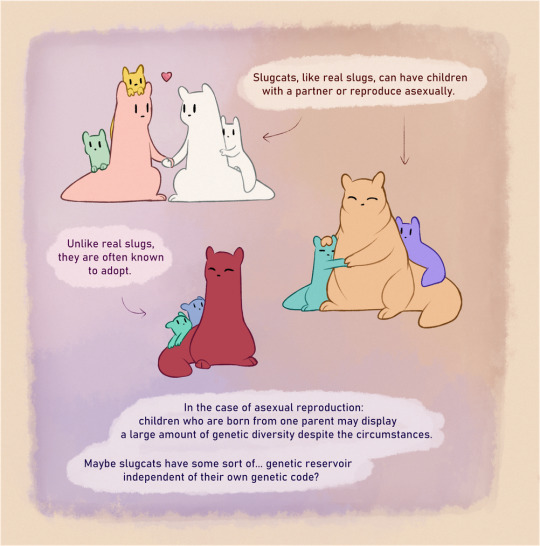
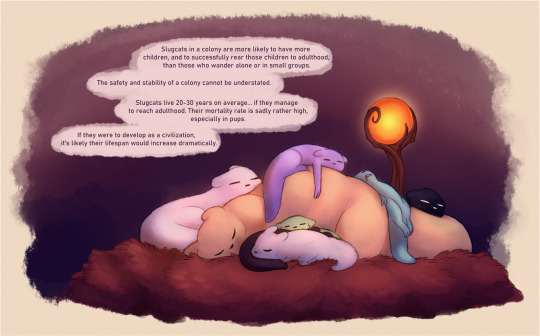
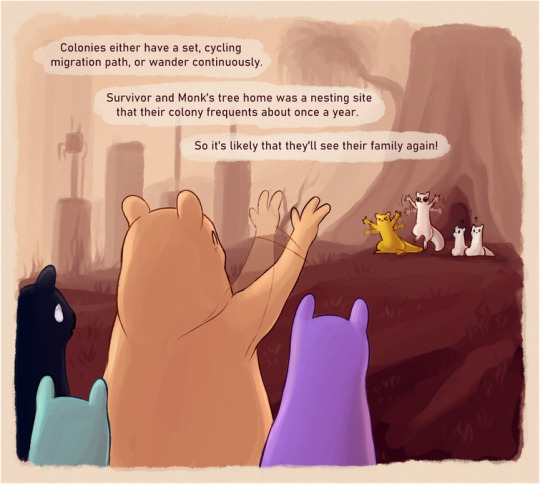


Playing with some ideas mostly regarding gender/reproduction in RW, and slugcat colonies.
Full transcript under the cut!
Creatures in Rain World are typically simultaneous hermaphrodites but require partners to reproduce, with either individual capable of being a genetic donor or carrier. Alongside what we are familiar with, this has lead to interesting reproductive strategies such as rotating donor/carrier roles, or dual/simultaneous genetic swaps.
Rotating donor/carrier roles - A K-selection reproductive strategy. One partner carries the first child, the other partner carries the next child, and so forth. Allows each partner to recover from the demands of childbearing.
Rain Deer aren't quite monogamous, but they tend to choose the same breeding partner whenever mating season rolls around. They serve as a donor one season, then bear and raise a child the next. Calves are raised away from the rain and worm grass, in places that have less food but more safety. Calf wool is softer, not yet gunked up by the dirty rainfall. Their legs are sturdier as children, allowing them to run for cover while the parent wards off threats.
Dual/simultaneous genetic swap - An r-selection reproductive strategy. Parents fulfill the donor and carrier role for each other. The more children you make, the more likely some are to survive!
Multiple batflies lay thousands of eggs in a single "blue fruit." Several eggs congeal and become nutrient paste for the surviving eggs (and for hungry slugcats). Like some plant seeds, batfly eggs that are consumed before pupating can survive passing through the digestive system. Ew.
Ancients also fell under this umbrella. Their genders (and the genders of iterators by extension, who have no sex anyways) could have been determined by a variety of other factors, such as societal role, donor/carrier preference, or simply different categorizations of personal expression.
It's difficult to say how well their common pronouns would translate to ours, but it seems they can translate to an extent, given what Moon and Pebbles use canonically.
Slugcats, like real slugs, can have children with a partner or self-fertilize. Unlike real slugs, they are often known to adopt.
In the case of self-fertilization: children who are born from one parent may display a large amount of genetic diversity despite the circumstances. Maybe slugcats have some sort of... genetic reservoir independent of their own genetic code?
Slugcats live 20-30 years on average... if they manage to reach adulthood. Their mortality rate is sadly rather high, especially in pups. If they were to develop as a civilization, it's likely their lifespan would increase dramatically.
Slugcats in a colony are more likely to have more children, and to successfully rear those children to adulthood, than those who wander alone or in small groups. The safety and stability of a colony cannot be understated.
Colonies either have a set, cycling migration path, or wander continuously. Survivor and Monk's tree home was a nesting site that their colony frequents about once a year. So it's likely that they'll see their family again!
...also, the strength of large colonies are why scavengers are likely to become the dominant species. In the time of Saint's era, continuous migration has become more of a risk, and it has become more difficult to support large populations. Slugcat populations have shrunk back to the more forgiving equatorial zones.
Saint's tongue is pretty unusual and probably unique to them, or to a small population that they hail from. Fur (of varying thickness) is much more common.
Meanwhile, scavengers are bulkier and covered in thicker insulating fur. They:
have seemingly massive populations
have a burgeoning society (the existence of merchants, tolls, bartering, elites and leaders)
are adept at communicating (non-verbally)
manipulate their environment
can build structures (scavenger-made structures were a scrapped idea from Saint's campaign)
can create complex weapons and tools
may have agriculture behind the scenes (unsure if scout parties prioritize exploration or hunting)
I would wager on scavengers developing more quickly than slugcats, but it would be nice if there was a future where both could co-exist.
#oops! impromptu rendering practice!#rotating donor/carrier roles could also be an r-selection strat#but i feel like it'd be more common as a k-selection strat#rain world#worldbuilding#headcanons#flickerdoodles#art#um#ask to tag?#that goes for all of my posts#rw spoilers#dp spoilers#saint spoilers#long post
2K notes
·
View notes
Text
The rain world brainworm is back again
I’m not very good at writing, but I wanna get better at making lore for things so I tried making a background for this threat theme
Corpus Callosum - The Twins
Two specially constructed superstructures compute the great problem in tandem, connected together with an intricate network of high-speed cables and water ducts. The space in between the two, the Corpus Callosum, is where the network is most dense, blocking out most if not all light from the outside. Over time many creatures have made their home in its dimly lit passages. However now, something is amiss. Synthetic organisms that glow with an eerie light have escaped from deep within one of the superstructures. The iterator inside rests in a vegetative state, for reasons unknown. These purposed creatures - once meant to maintain an iterator’s vast systems - have become misshapen, dutifully acting on broken and distorted directives after centuries of neglect. Having long since forgotten the concept of what is “inside” the iterator, they single-mindedly construct auxiliary memory banks, mercilessly hostile to any life unlucky enough to be in their way.
54 notes
·
View notes
Text

Just because I sorta enjoy it here's my funny rainworld canvas
#art#digital art#speculative biology#artists on tumblr#worldbuilding#rain world downpour#rainworld art#rain world iterator#rw art#rw iterator
207 notes
·
View notes
Text
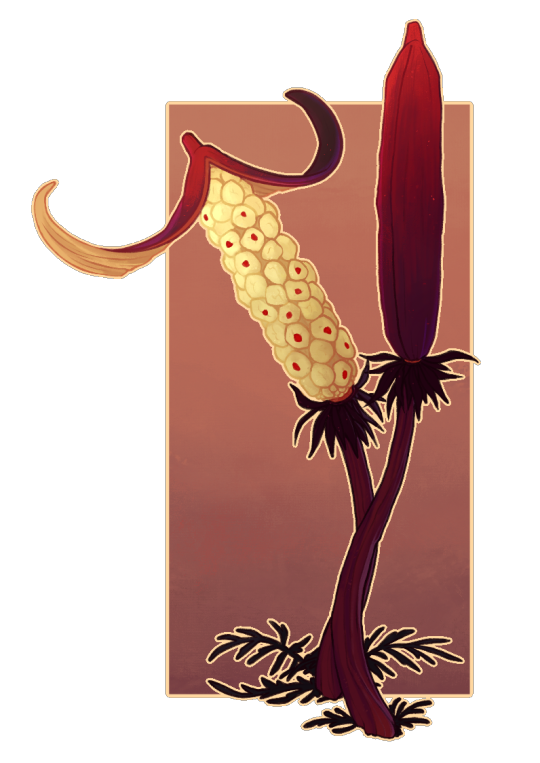
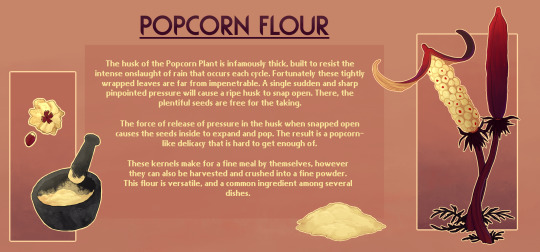
In regards of taste, if you stuff your face with the flour as is, it's mostly like cornmeal and unsalted popcorn.
#rain world#rain world fanart#rain world downpour#worldbuilding#rw worldbuilding#speculative biology#spec bio#fanart#delicious in rain world
641 notes
·
View notes